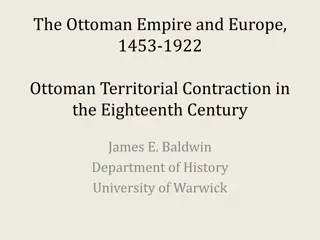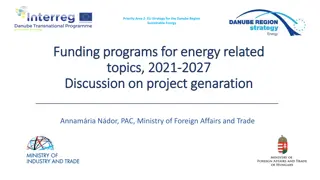Integrated Territorial Development in Europe 2021-2027
Programming Policy Objective 5 (PO5), led by Wallis Goelen, focuses on integrated territorial development in Europe for the period 2021-2027. PO5 aims to address diverse local needs through methods like CLLD and ITI, fostering sustainability in urban and rural areas. Integrated Territorial Development emphasizes shared management and multi-level governance for cohesive strategies and interventions to support territorial development under the Cohesion Policy.
Uploaded on Sep 16, 2024 | 1 Views
Download Presentation

Please find below an Image/Link to download the presentation.
The content on the website is provided AS IS for your information and personal use only. It may not be sold, licensed, or shared on other websites without obtaining consent from the author.If you encounter any issues during the download, it is possible that the publisher has removed the file from their server.
You are allowed to download the files provided on this website for personal or commercial use, subject to the condition that they are used lawfully. All files are the property of their respective owners.
The content on the website is provided AS IS for your information and personal use only. It may not be sold, licensed, or shared on other websites without obtaining consent from the author.
E N D
Presentation Transcript
PO5 Europe closer to citizens Programming integrated territorial development in 2021-2027 Wallis Goelen October 2019 Senior expert attached to the Deputy Director General of DG REGIO
1. Understanding PO5: Objective? Method? Tool?
Policy objective 5 Objective? Method? Tool? PO5 is a cross-cutting territorial policy objective to address the diverse and interlinked territorial and local needs and challenges. PO5 entails a specific method of integrated territorial development, that requires place-based and integrated strategies, local empowerment and partnership. PO5 must be achieved via territorial tools: CLLD, ITI, or other territorial tools. Other territorial tools only possible under PO5 and ERDF (or under any funds and/or PO PGA). Must also comply with the minimum requirements CLLD and ITI also available outside PO5 and can be multi-fund
The territorial policy objective Foster economic, social, and environmental sustainability and resilience in all places. Urban context: to benefit from agglomeration economies and positive spill- overs towards the wider functional urban areas and rural areas close to cities to address negative effects of concentration (traffic congestion, pollution, urban sprawl, affordable housing, poverty etc) Other territories: to build on the potentials and specific assetsof remote rural areas and local communities (beyond compensatory measures) to overcome the negative effects of low density and peripherality (access to jobs and services, pooling resources)
The method Integrated Territorial Development Shared management (Partnership + Multi-level governance) What is integrated? Multi-sectoral Multi-level COHESION POLICY Multi-stakeholder Integrated Place-based Multi-territorial Macroregional strategies Partnership Agreement Programmes Territorial strategies (Art. 23) Local strategies (Art. 26) Transnational/cross-border National Regional/national Functional (Functional urban area) Subregional (Metropolitan region) Local admin (City/town/suburb) Community (Urb. neighbourhood) SUD 6% Community-led What is Integrated Territorial Development? (Art. 22) Territorial tools - ITI (PO1-5) - CLLD (PO1-5) - Other (PO5)
Minimum requirements for 2021-2027 Key requirements to operationalise Cohesion Policy support to Integrated Territorial Development (CPR Art 23 for all territorial strategies and Art 25-28 for CLLD local strategies) Interventions linked to territorial or local strategies drawn up by local or territorial bodies Definition of the targeted area according to needs (must be urban for 6%) Locally coordinated interventions through an integrated approach (cross-sectoral, multi-territorial or multi- stakeholder) Relevant local or territorial bodies involved in project selection Partnership with relevant actors to be ensured at local level
Rationale for integrated and place- based approach The EU must be able to respond to the expectations of its citizens, irrespective of where they live The number of place-based sectorial initiatives, notably targeting cities, is booming rapidly, but nor national, nor regional, nor local sectoral measures can alone deliver sufficient results. Need for economic, social, and environmental sustainability and resilience in all places Different territories and communities require differentiated and tailor-made policy mixes 7
The territorial tools in 2021-2027 Support from the Funds to be provided for integrated territorial and local development in forms of: Other territorial tool: Allowed when a territorial strategy receives funding only through PO5 priority or programme (CPR Art 22(c)) ITI: Necessary when territorial strategy receives funding from multiple priorities or even programmes, funds or POs (not exclusive to PO5), (CPR Art 24) CLLD: Specific delivery method to enhance the participatory approach (not exclusive to PO5), (CPR Art 25-28)
Support only through PO5 (other territorial tool, CLLD) Provides continuation for the multi-thematic urban and CLLD priority axis and other national tools More suitable for experimentation and integrated local projects All intervention fields and indicators are available to monitor thematic inputs, outputs and results Special attention: Coordination with sectoral policies ERDF/CF Programme PO2 PO1 PO2 PO5 PO1 Territorial strategy
Support through PO5 and other POs (ITI, CLLD) A very comprehensive way to provide support to a territorial strategy Can be suitable for a territorial strategy with a substantial support from Cohesion Policy Suitable to ensure the link with sectoral policies (enabling conditions, TC) Can include multiple tools and strategies (e.g. CLLD strategies within ITI strategy) Special attention: coordination across the different strands, governance and monitoring need to be adapted ERDF/CF Programme ERDF/CF Programme PO4 PO2 PO4 PO1 PO2 PO5 PO1 PO3 ESF Prog. PO4 PO4 PO4 Territorial Strategy
Support outside PO5 (ITI, CLLD) Concentrate the ERDF support to a limited number of locally relevant themes Suitable for a country/region with high thematic concentration and/or small allocation At least two priority, and the local strategy must be integrated also in this case Special attention: integrated approach and the role of local level (minimum requirements) need to be ensured ERDF/CF Programme PO2 PO1 PO2 PO2 PO1 Territorial Strategy
Thematic concentration and PO5 programming ERDF/CF Programme PO2 PO2 PO1 PO5 PO1 Contributes to thematic concentration Does not contribute to thematic concentration Territorial Strategy
ERDF thematic concentration Requirements refer to budgetary allocations at priority level and NOT indicative types of intervention Policy objective 5 is outside the thematic concentration (types of actions falling within the scope of PO 1 and 2, but programmed under PO5 do not count for the thematic concertation) ITI and CLLD (or other territorial tools PGA), which implement actions programmed under priorities related to PO1 and PO2 count into thematic concentration
Summary of main changes 2014-2020 Integrated territorial development treated horizontally (SUD, ITI, areas affected by poverty, geographic specificities etc.) Different set of rules for strategies depending on the territorial tools (SUD ITI, non- SUD ITI, CLLD, urban priority axis etc.) Specific role and obligatory IB status for urban authorities Guidance: integrated if strategy has at least two contributing thematic obj. ITI tool and multi-thematic priorities to draw funding from multiple thematic objectives Proposed for 2021-2027 Integrated territorial development has its own cross- cutting policy objective - Europe closer to citizens (PO5) Same basic requirements for all territorial and local strategies, introduced in the regulation (only CLLD requires a different method) Specific role without IB status for all tools Programmes to define integrated approach for strategies No multi-fund within PO5 priority (only with ITI and CLLD) No thematic concentration within PO5 priority (only with ITI and CLLD)























